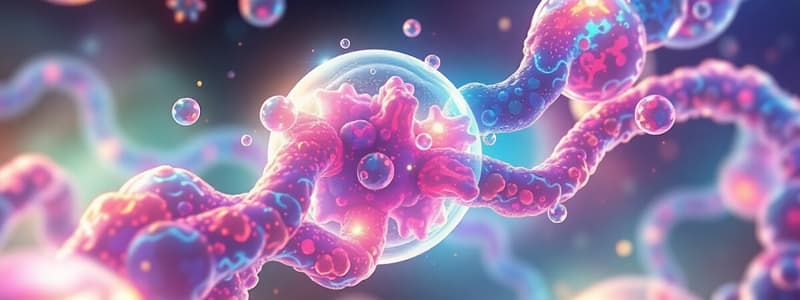Podcast
Questions and Answers
Which type of enzyme inhibition occurs when an inhibitor binds to the active site, preventing substrate binding?
Which type of enzyme inhibition occurs when an inhibitor binds to the active site, preventing substrate binding?
- Allosteric inhibition
- Competitive inhibition (correct)
- Uncompetitive inhibition
- Non-competitive inhibition
In non-competitive inhibition, the binding of the inhibitor affects which aspect of enzyme activity?
In non-competitive inhibition, the binding of the inhibitor affects which aspect of enzyme activity?
- Only the substrate binding affinity
- Both maximum velocity (V_max) and Michaelis constant (K_m)
- Michaelis constant (K_m) only
- Maximum velocity (V_max) only (correct)
What is the characteristic outcome of uncompetitive inhibition on a reaction's kinetics?
What is the characteristic outcome of uncompetitive inhibition on a reaction's kinetics?
- Increase in K_m
- Decrease in V_max and K_m (correct)
- Decrease in K_m without effect on V_max
- Increase in V_max without changing K_m
How do allosteric enzymes differ from standard enzymes in terms of regulation?
How do allosteric enzymes differ from standard enzymes in terms of regulation?
What is feedback inhibition primarily used for in biological pathways?
What is feedback inhibition primarily used for in biological pathways?
Which statement about competitive inhibitors is TRUE?
Which statement about competitive inhibitors is TRUE?
Which of the following is NOT a characteristic of uncompetitive inhibition?
Which of the following is NOT a characteristic of uncompetitive inhibition?
Which phenomenon describes when the product of a reaction acts to inhibit an earlier step in the pathway?
Which phenomenon describes when the product of a reaction acts to inhibit an earlier step in the pathway?
Which type of enzyme inhibition is characterized by the inhibitor binding only to the enzyme-substrate complex, thereby preventing the reaction from proceeding?
Which type of enzyme inhibition is characterized by the inhibitor binding only to the enzyme-substrate complex, thereby preventing the reaction from proceeding?
What describes competitive inhibition in enzyme activity?
What describes competitive inhibition in enzyme activity?
Which type of inhibition affects both the enzyme and the enzyme-substrate complex equally?
Which type of inhibition affects both the enzyme and the enzyme-substrate complex equally?
Feedback inhibition in a metabolic pathway generally serves to:
Feedback inhibition in a metabolic pathway generally serves to:
Allosteric enzymes are differentiated from other enzymes because they:
Allosteric enzymes are differentiated from other enzymes because they:
What happens to the Km value of an enzyme in the presence of a competitive inhibitor?
What happens to the Km value of an enzyme in the presence of a competitive inhibitor?
In the presence of a noncompetitive inhibitor, what effect would you expect on the maximum rate (Vmax) of the enzyme reaction?
In the presence of a noncompetitive inhibitor, what effect would you expect on the maximum rate (Vmax) of the enzyme reaction?
An allosteric activator would typically lead to which of the following outcomes?
An allosteric activator would typically lead to which of the following outcomes?
Which statement accurately describes the relationship between substrate concentration and enzyme activity?
Which statement accurately describes the relationship between substrate concentration and enzyme activity?
What distinguishes a competitive inhibitor from other types of enzyme inhibitors?
What distinguishes a competitive inhibitor from other types of enzyme inhibitors?
In noncompetitive inhibition, what happens to the enzyme kinetics?
In noncompetitive inhibition, what happens to the enzyme kinetics?
What is the effect of uncompetitive inhibitors on enzyme activity?
What is the effect of uncompetitive inhibitors on enzyme activity?
Which of the following best describes allosteric enzymes?
Which of the following best describes allosteric enzymes?
What role does feedback inhibition play in metabolic pathways?
What role does feedback inhibition play in metabolic pathways?
Which statement accurately describes competitive feedback inhibition?
Which statement accurately describes competitive feedback inhibition?
Which of the following best explains noncompetitive feedback inhibition?
Which of the following best explains noncompetitive feedback inhibition?
What role do allosteric enzymes play in metabolic pathways?
What role do allosteric enzymes play in metabolic pathways?
What is the characteristic feature of uncompetitive inhibition?
What is the characteristic feature of uncompetitive inhibition?
Which enzyme is inhibited by cholesterol during feedback inhibition?
Which enzyme is inhibited by cholesterol during feedback inhibition?
What would happen to enzyme activity when too much product is produced in a feedback inhibition system?
What would happen to enzyme activity when too much product is produced in a feedback inhibition system?
Which allosteric enzyme is activated by AMP?
Which allosteric enzyme is activated by AMP?
Which of the following is a common characteristic of allosteric inhibitors?
Which of the following is a common characteristic of allosteric inhibitors?
Which of the following statements about feedback inhibition is true?
Which of the following statements about feedback inhibition is true?
What is a common property of agents that can denature enzyme activity?
What is a common property of agents that can denature enzyme activity?
Which type of inhibition is characterized by an inhibitor binding only to the enzyme-substrate complex?
Which type of inhibition is characterized by an inhibitor binding only to the enzyme-substrate complex?
Which of the following statements is true regarding allosteric enzymes?
Which of the following statements is true regarding allosteric enzymes?
What is the main result of noncompetitive inhibition on an enzyme's kinetic parameters?
What is the main result of noncompetitive inhibition on an enzyme's kinetic parameters?
Which drug serves as an uncompetitive inhibitor of liver alcohol dehydrogenase?
Which drug serves as an uncompetitive inhibitor of liver alcohol dehydrogenase?
Heavy metals such as Ag²+, Hg²+, and Pb²+ are known to act as which type of inhibitors?
Heavy metals such as Ag²+, Hg²+, and Pb²+ are known to act as which type of inhibitors?
In feedback inhibition, the end product of a metabolic pathway...
In feedback inhibition, the end product of a metabolic pathway...
What is the effect of uncompetitive inhibition on both Vmax and Km?
What is the effect of uncompetitive inhibition on both Vmax and Km?
Atorvastatin is primarily used to treat which condition?
Atorvastatin is primarily used to treat which condition?
Which enzyme is inhibited by pepstatin?
Which enzyme is inhibited by pepstatin?
The action of drugs that treat methanol poisoning is an example of which type of inhibition?
The action of drugs that treat methanol poisoning is an example of which type of inhibition?
Flashcards
Enzyme Concentration
Enzyme Concentration
The amount of enzyme present directly affects the reaction speed, provided substrate is abundant.
Substrate Specificity
Substrate Specificity
Enzymes bind only specific substrates because of their shape, like a lock and key.
Enzyme Catalysis
Enzyme Catalysis
Enzymes speed up reactions by binding to substrates, facilitating the reaction, and releasing products, without changing themselves.
Michaelis-Menten Equation
Michaelis-Menten Equation
Signup and view all the flashcards
Michaelis Constant ($K_m$)
Michaelis Constant ($K_m$)
Signup and view all the flashcards
Enzyme Activators
Enzyme Activators
Signup and view all the flashcards
Enzyme Inhibition
Enzyme Inhibition
Signup and view all the flashcards
Competitive Inhibition
Competitive Inhibition
Signup and view all the flashcards
Enzyme Activity
Enzyme Activity
Signup and view all the flashcards
Temperature Effect on Enzymes
Temperature Effect on Enzymes
Signup and view all the flashcards
pH Effect on Enzymes
pH Effect on Enzymes
Signup and view all the flashcards
Substrate Concentration Effect
Substrate Concentration Effect
Signup and view all the flashcards
Enzyme Concentration Effect
Enzyme Concentration Effect
Signup and view all the flashcards
Allosteric Regulation
Allosteric Regulation
Signup and view all the flashcards
Feedback Inhibition
Feedback Inhibition
Signup and view all the flashcards
Optimal Temperature
Optimal Temperature
Signup and view all the flashcards
Enzyme Denaturation
Enzyme Denaturation
Signup and view all the flashcards
Irreversible Inhibition
Irreversible Inhibition
Signup and view all the flashcards
Active Site Inhibition
Active Site Inhibition
Signup and view all the flashcards
Suicidal Inhibitors
Suicidal Inhibitors
Signup and view all the flashcards
Reversible Inhibition
Reversible Inhibition
Signup and view all the flashcards
Non-competitive Inhibition
Non-competitive Inhibition
Signup and view all the flashcards
Denaturation
Denaturation
Signup and view all the flashcards
Glucokinase vs. Hexokinase
Glucokinase vs. Hexokinase
Signup and view all the flashcards
Km (Michaelis Constant)
Km (Michaelis Constant)
Signup and view all the flashcards
Metal Ion Activation
Metal Ion Activation
Signup and view all the flashcards
Statin Function
Statin Function
Signup and view all the flashcards
Allopurinol's Target
Allopurinol's Target
Signup and view all the flashcards
What does Methotrexate inhibit?
What does Methotrexate inhibit?
Signup and view all the flashcards
Captopril & Enalapril Effect
Captopril & Enalapril Effect
Signup and view all the flashcards
Dicoumarol's Mechanism
Dicoumarol's Mechanism
Signup and view all the flashcards
Allosteric Enzymes
Allosteric Enzymes
Signup and view all the flashcards
Example of Uncompetitive Inhibition
Example of Uncompetitive Inhibition
Signup and view all the flashcards
Study Notes
Enzyme Activity Factors
- Factors affecting enzyme activity include temperature, pH, substrate concentration, enzyme concentration, and metals.
Regulation of Enzyme Activity
- Regulation of enzyme activity involves inhibition, allosteric regulation, and feedback inhibition.
Factors Affecting Enzyme Activity
- Environmental Conditions: Temperature and pH are key environmental factors affecting enzyme activity.
- Cofactors and Coenzymes: Certain non-protein molecules, like metal ions, are required for enzyme function and activity.
- Enzyme Inhibitors: Substances that decrease enzyme activity.
Temperature
- Optimum temperature allows the greatest number of molecular collisions.
- Human enzymes generally function optimally at 35-40°C (body temperature is 37°C.
- High temperatures can disrupt bonds in the enzyme causing denaturation (loss of 3D shape).
- Low temperatures reduce molecular movement and decrease collisions between enzyme and substrate, reducing activity.
- Denaturation also occurs at extreme pH.
pH
- Enzymes have optimal pH values; values outside these ranges will disrupt bond interactions that maintain the enzyme's 3D shape, causing denaturation.
- Pepsin has an optimum pH of 1.4-2 in the stomach while trypsin functions optimally in a range of 7.7-8.
Substrate Concentration
- Increasing substrate concentration increases the velocity of enzyme reaction within a limited range.
- A rectangular hyperbola graph is observed when substrate velocity is plotted against substrate concentration.
- Three distinct reaction phases are seen on this graph (Initially linear reaction, intermediate curve, and nearly constant reaction rate).
Enzyme Concentration
- The rate of a reaction or velocity is directly proportional to enzyme concentration when sufficient substrate is present.
- Increasing enzyme concentration proportionally increases reaction velocity if sufficient substrate is available.
Substrate Specificity
- Enzymes catalyze specific substrate(s).
- Substrate binds to enzyme's active site.
- Enzyme-substrate complex formation occurs via hydrogen bonds.
- Induced fit: Enzyme shape changes to fit substrate tightly.
Enzyme Catalysis
- The enzyme does not change during catalysis.
- The enzyme is ready for the next reaction after the product is released.
Effect of Activators
- Some enzymes require inorganic metal ions for optimum activity (e.g., Mn, Zn, Cu, Fe, Co).
- Metals can combine with the substrate directly or participate in reaction mechanisms, inducing a conformational change in the enzyme.
Michaelis-Menten Equation
- An equation describing how reaction velocity varies with substrate concentration.
- V₀ = Vmax [S] / (Km + [S]), where:
- V₀ is the initial reaction velocity
- Vmax is the maximum velocity
- Km is the Michaelis constant
- [S] is the substrate concentration
Michaelis Constant (Km)
- Km represents the substrate concentration at which the reaction rate is half of the maximum rate (Vmax/2).
- Km is a measure of the enzyme's affinity for its substrate, Higher Km means a lower affinity. Lower Km indicates a high affinity.
Enzyme Inhibition
-
Types of Inhibition:
-
Reversible inhibitors bind noncovalently. • Competitive: inhibitor competes with substrate for active site • Noncompetitive: binds to a site other than the active site • Uncompetitive: binds only to the enzyme-substrate complex.
-
Irreversible inhibitors bind covalently to the enzyme
-
Active site directed
-
Suicidal inhibitors
-
Examples of Inhibition: many examples of inhibitors are given across different pages of content.
Allosteric Enzymes
- Allosteric enzymes have multiple active sites.
- Binding of a modulator to a site other than the substrate active site can permanently change the enzyme's conformation.
Feedback Inhibition
- The product of a reaction can act as a signal molecule inhibiting the enzyme responsible for its production.
- This is a system of enzyme regulation via repressor molecules.
- It's a mechanism for self-regulation, where high product concentrations stop catalysis, and low product concentrations allow catalysis to continue.
Studying That Suits You
Use AI to generate personalized quizzes and flashcards to suit your learning preferences.




